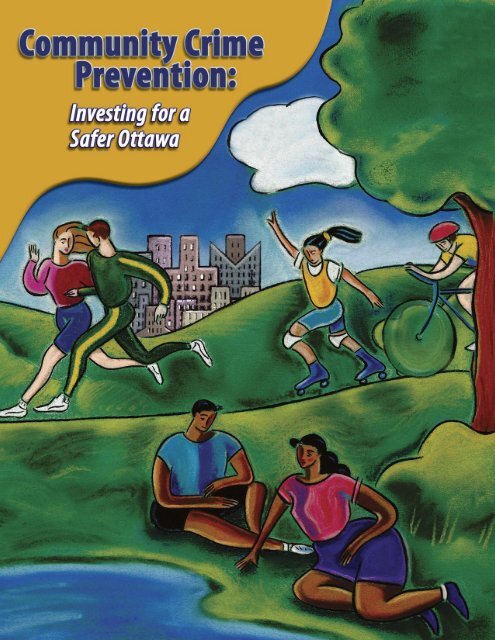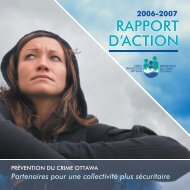Community Crime Prevention: Investing for a Safer Ottawa
Community Crime Prevention: Investing for a Safer Ottawa
Community Crime Prevention: Investing for a Safer Ottawa
You also want an ePaper? Increase the reach of your titles
YUMPU automatically turns print PDFs into web optimized ePapers that Google loves.
September 2004<br />
<strong>Community</strong> <strong>Crime</strong> <strong>Prevention</strong>:<br />
<strong>Investing</strong> <strong>for</strong> a <strong>Safer</strong> <strong>Ottawa</strong><br />
PANEL FOR COMMUNITY CRIME PREVENTION – MEMBERS:<br />
• MICHAEL ALLEN, President/Executive Director, United Way <strong>Ottawa</strong><br />
• VINCE BEVAN, Chief, <strong>Ottawa</strong> Police Services<br />
• FRED CHRYSTAL, Superintendent, <strong>Ottawa</strong>-Carleton Catholic School Board (OCCSB)<br />
• MARION DEWAR, Former <strong>Ottawa</strong> Mayor and ex-Chair, Police Services Board (PSB)<br />
• STEVE KANELLAKOS, Deputy City Manager, <strong>Community</strong> and Protective Services<br />
• JACQUES LEGENDRE, Councillor, City of <strong>Ottawa</strong><br />
• BARBARA MCINNES, President, <strong>Community</strong> Foundation of <strong>Ottawa</strong><br />
• RUSSELL MILLS, Dean of Media & Design, Algonquin College<br />
• DAN PARÉ, Executive Director, Youth Services Bureau<br />
• DR. LORNE RACHLIS, Director of Education, <strong>Ottawa</strong>-Carleton District School Board<br />
(OCDSB)<br />
• LISE ST-ÉLOI, Surintendante de l’Éducation, Conseil des Écoles Catholiques de<br />
Langue Française de Centre-Est<br />
• CLAUDE TURGEON, Executive Director, Boys & Girls Club of <strong>Ottawa</strong><br />
• DR. IRVIN WALLER, Professor, Criminology, University of <strong>Ottawa</strong>
TABLE OF CONTENTS<br />
EXECUTIVE SUMMARY 3<br />
INTRODUCTION 6<br />
<strong>Ottawa</strong> 20/20 vision, community safety, and crime prevention 6<br />
Federation of Canadian Municipalities (FCM) calls <strong>for</strong> municipal leadership 8<br />
<strong>for</strong> crime prevention<br />
CRIME AND VICTIMIZATION IN OTTAWA AND CANADA 8<br />
PREVENTION CUTS CRIME SIGNIFICANTLY 10<br />
Successes with families, children, and youth 10<br />
Successes in community design 11<br />
Successes through strategic policing 12<br />
CITIES AS SPEARHEAD FOR EFFECTIVE CRIME PREVENTION 12<br />
Role and responsibilities of a municipally-led crime prevention coalition 13<br />
Other Canadian cities invest in crime prevention 14<br />
DOLLARS AND SENSE OF PREVENTION 15<br />
A SAFE COMMUNITY VISION FOR OTTAWA 16<br />
<strong>Safer</strong> homes 17<br />
<strong>Safer</strong> streets 18<br />
<strong>Safer</strong> schools 18<br />
<strong>Safer</strong> workplaces 19<br />
HOW DO WE GET THERE? 19<br />
ENDNOTES 22<br />
2
EXECUTIVE SUMMARY<br />
The <strong>Ottawa</strong> 20/20 Growth Management Strategy recognizes that “it is always easier, cheaper,<br />
and more compassionate to prevent problems be<strong>for</strong>e they occur than to develop solutions after<br />
the fact”(Human Services Plan, p.44).<br />
This is particularly true when addressing crime problems. By investing in families, children, and<br />
youth, crime prevention significantly cuts crime, is cost-effective and economically beneficial in<br />
the long run, and provides additional social benefits. It’s simply easier and cheaper to prevent<br />
crime from happening in the first place than to deal with it once it occurs.<br />
With a rapidly changing City, a tight municipal budget, and a police budget that is continually<br />
increasing, it’s time <strong>for</strong> <strong>Ottawa</strong> to consider a different way of doing business when it comes to<br />
crime and community safety.<br />
Even with increases in police budgets, the Federation of Canadian Municipalities (FCM) points<br />
to a lack of apparent reduction in crime in Canadian communities over the past 40 years. To<br />
significantly reduce crime, FCM urges city leaders to create and support a municipally-led<br />
infrastructure to integrate local initiatives within a comprehensive crime prevention strategy.<br />
CRIME AND VICTIMIZATION IN OTTAWA AND CANADA<br />
‣ <strong>Ottawa</strong>’s crime rates, <strong>for</strong> most categories, increased in 2003<br />
‣ <strong>Ottawa</strong> crime increased by 3% in 2003 compared to decreases elsewhere<br />
‣ Many suffer from “hidden” crimes in silence (e.g., bullying, sexual assault, and<br />
family/spousal violence)<br />
<strong>Ottawa</strong> may be a relatively safe city, but we still need to address the number of people being<br />
victimized each year. And why wait until things get worse? Now is the time to act.<br />
PREVENTION CUTS CRIME SIGNIFICANTLY<br />
Prestigious organizations worldwide – like the United Nations, World Health Organization,<br />
International Centre <strong>for</strong> the <strong>Prevention</strong> of <strong>Crime</strong>, and U.S. Surgeon General - stress that targeting<br />
the “root causes of crime” successfully cuts crime and victimization, and provides collateral<br />
social benefits. For example, improving parenting skills in high-risk families can reduce future<br />
arrests by up to 66% and cut child abuse by 62%-79%. Providing incentives <strong>for</strong> youth to<br />
complete high school can reduce arrests by up to 71%, and increase post-secondary education by<br />
26%. “What works” in crime prevention is clear, compelling, and repeatedly recognized.<br />
CITIES AS SPEARHEAD FOR EFFECTIVE CRIME PREVENTION<br />
A City coalition with a high-level leader is crucial in gaining the support and participation of the<br />
key partners able to influence the root causes of crime. Under City leadership, a local crime<br />
prevention coalition can establish a clear community safety strategy based on the diagnosis of<br />
3
crime problems, the elaboration of an action plan, the co-ordinated implementation of actions,<br />
and rigorous evaluation of process and impacts.<br />
Without the leadership of the City, it’s difficult to successfully rally all key stakeholders and<br />
complete these necessary steps. <strong>Ottawa</strong> needs an integrated, planned, and supported response to<br />
preventing crime by investing in “what works” <strong>for</strong> families, children, and youth. Other Canadian<br />
Cities, like Toronto, Montreal, Waterloo, and Winnipeg are already investing in evidence-based<br />
crime prevention and making significant contributions to community safety.<br />
DOLLARS AND SENSE OF PREVENTION<br />
Preventing crime be<strong>for</strong>e it happens is cost-efficient and also cost-beneficial, as healthy kids and<br />
youth make productive adults later on. For example, to reduce serious crime by 10%, you can<br />
either provide incentives <strong>for</strong> at-risk youth to complete high school – which also contributes to<br />
enrolment in post-secondary education – or spend over 7 times more in tax dollars per household<br />
to increase incarceration.<br />
<strong>Crime</strong> prevention is not a matter of spending more, but of spending more wisely. By annually<br />
investing $1.50 per resident in a crime prevention responsibility centre, Montreal has<br />
significantly reduced the City’s levels of crime and victimization by up to 50%.<br />
A SAFE COMMUNITY VISION FOR OTTAWA<br />
Based on the evidence of “what works” to cut crime, it is possible to make specific short and<br />
long-term projections <strong>for</strong> a safer <strong>Ottawa</strong>. By investing in an integrated crime prevention strategy<br />
– that is by implementing best practices and incorporating successful services and programs<br />
already underway in <strong>Ottawa</strong> - victimization at home, on streets, at school and at work could be<br />
lowered by up to 50% in 2 to 5 years.<br />
HOW DO WE GET THERE?<br />
‣ Establish a permanent crime prevention responsibility centre to reduce crime and enhance<br />
community safety in <strong>Ottawa</strong> through evidence-based crime prevention.<br />
1. Board of Directors<br />
Establish a Board of Directors with strong links to the City of <strong>Ottawa</strong> and representatives<br />
from other key stakeholders:<br />
‣ seats will be allocated <strong>for</strong> City representatives (e.g., Mayor and City Councillor), <strong>for</strong><br />
a high-level City administrator (e.g., Deputy City Manager), <strong>for</strong> a high-level<br />
representative from the School Boards and from the <strong>Ottawa</strong> Police Service<br />
‣ the Panel <strong>for</strong> <strong>Community</strong> <strong>Crime</strong> <strong>Prevention</strong> will name a Nominating Committee<br />
charged with proposing other Board Members according to set criteria<br />
• Nominees will represent key stakeholders able to contribute to community<br />
safety and influence the underlying causes of crime in <strong>Ottawa</strong><br />
4
2. Staff<br />
Secondment of 2 full-time staff from the <strong>Community</strong> and Protective Services (CPS)<br />
department<br />
‣ the Board of Directors will establish criteria <strong>for</strong> 2 full-time positions, and a<br />
competition will be held within the CPS department <strong>for</strong> 2-year terms:<br />
• 1 employee will serve as the centre’s Executive Director<br />
• 1 employee will serve as the centre’s <strong>Community</strong> Development Officer<br />
3. Responsibilities of the crime prevention coalition<br />
The coalition’s responsibilities are centred on strategically developing and implementing a<br />
community-wide crime prevention plan, and monitoring and evaluating the process and<br />
impacts of this plan. Specific responsibilities include co-ordinating and mobilizing key<br />
players and resources, conducting strategic analysis of <strong>Ottawa</strong> crime and its causes, coordinating<br />
actions, providing expertise, resources, and capacity development, and reporting at<br />
least annually on activities, progress, and outcomes.<br />
4. Funds and resources<br />
The coalition will seek contributions and donations in-kind from key stakeholders <strong>for</strong> office<br />
equipment and other administrative necessities.<br />
To get project-specific funding from other levels of government and additional funds from<br />
the private sector, core funding is needed to come up with an appropriate mandate and plan<br />
of action with specific targets and goals. The request from City Council is there<strong>for</strong>e a<br />
contribution of $200,000 in 2005 and $400 000 in 2006.<br />
Although it is an added cost to this year’s budget, this contribution will reduce the mounting<br />
financial costs of reacting to crime in <strong>Ottawa</strong>, and show that City leaders are dedicated to<br />
<strong>Ottawa</strong>’s 20/20 vision <strong>for</strong> community safety and preventative action.<br />
The best time to act would be 5 years ago. The second best time is now. The worse time is 5<br />
years from now.<br />
5
INTRODUCTION<br />
With the economic and social future of <strong>Ottawa</strong> in mind, the City is working towards a 20/20<br />
Vision <strong>for</strong> sustainable development. The City’s Growth Management Strategy outlines 7<br />
Guiding Principles, including A Caring and Inclusive City characterized in part by Personal<br />
Safety and Security, where people feel safe in their homes and communities (City of <strong>Ottawa</strong><br />
Official Plan, Section 1.3, p.2).<br />
To this end, the City of <strong>Ottawa</strong> Human Services Plan outlines 5 strategic directions, including<br />
Safe and Healthy Communities and a Focus on <strong>Prevention</strong> (p.19).<br />
An attractive City is one where residents feel safe on their streets,<br />
in their homes, at school, at work, and at play. To get there, the<br />
City recognizes that “it is always easier, cheaper, and more<br />
compassionate to prevent problems be<strong>for</strong>e they occur than to<br />
develop solutions after the fact”(Human Services Plan, p.44).<br />
“Safe communities provide<br />
<strong>for</strong> a better quality of life, and<br />
enhanced opportunities <strong>for</strong><br />
economic development,<br />
investment, and tourism”<br />
(FCM, 2004).<br />
This is particularly true when addressing crime problems. By investing in the well being of<br />
families, children, and youth, crime prevention 1 :<br />
‣ significantly cuts crime<br />
‣ is cost-effective and economically beneficial in the long run<br />
‣ provides additional social benefits (lower health costs, employment, paid taxes…)<br />
When it comes to crime, it’s simply easier and cheaper to prevent it from happening in the first<br />
place than to deal with it once it occurs.<br />
Although municipal law en<strong>for</strong>cement taxes cost about $175 per capita in <strong>Ottawa</strong> every year 2 , the<br />
overall societal costs of crime and victimization in <strong>Ottawa</strong> are around $1.16 billion annually<br />
(National <strong>Crime</strong> <strong>Prevention</strong> Centre, 2003 3 ). This represents the costs associated with crime, such<br />
as, injuries, insurance, private security measures. Not to mention the loss, fear, trauma, and longterm<br />
physical injury that crime and victimization can inflict on victims.<br />
Despite the criminal justice system’s important role in community safety, there has been little<br />
apparent reduction in crime by investing in more police and prisons over the years. It makes no<br />
sense to keep paying <strong>for</strong> and relying on more of the same to reduce crime (FCM, 2004).<br />
As one of the fastest growing cities in Canada, <strong>Ottawa</strong> faces many challenges in the years to<br />
come. The number of immigrants living in <strong>Ottawa</strong> is expected to double by 2020, and new<br />
Canadians are 4 times more likely to be unemployed than any other group. Other social factors<br />
related to crime – like the gap between high and low income families, the need <strong>for</strong> child<br />
protection services involvement, the number of lone-parent families, and lack of af<strong>for</strong>dable<br />
housing - are also consistently climbing and expected to escalate in <strong>Ottawa</strong> over the next 5 to 10<br />
years 4 .<br />
The <strong>Ottawa</strong> Human Services Plan recognizes that “a number of programs and services<br />
are in place to serve families and children in <strong>Ottawa</strong>…however, a number of service gaps<br />
continue, particularly with respect to meeting the needs of children aged 6-12” (p.29-30).<br />
6
Since teens aged 15-19 years are at greater risk of being both crime victims and offenders 5 , an<br />
expected increase of 24% in youth aged 10-19 over the next 10 years in <strong>Ottawa</strong> 6 also points to<br />
the need <strong>for</strong> preventative action now.<br />
With the changing and broadening scope of policing, the <strong>Ottawa</strong> Police Service notes that it’s<br />
becoming increasingly difficult <strong>for</strong> municipalities to continue to fund increasing police budgets 7 .<br />
To continue running its 3-5 year operating plans, the <strong>Ottawa</strong> Police Service will require<br />
additional funding in the range of $10-11 million annually in both 2005 and 2006 8 .<br />
To put a stop to the increasing costs of reacting to crime - and reduce the need to hire more and<br />
more police officers over the next 2-5 years - the City of <strong>Ottawa</strong> should be investing in what is<br />
proven to reduce the levels of crime and insecurity: preventing crime by strategically investing in<br />
families, children and youth.<br />
<strong>Ottawa</strong> needs an integrated and coordinated municipally-led strategy <strong>for</strong> community safety and<br />
crime prevention. Many prestigious international organizations – like the International Centre <strong>for</strong><br />
the <strong>Prevention</strong> of <strong>Crime</strong>, United Nations, and World Health Organization - stress the critical role<br />
that local governments play in ensuring the success of community safety through strategic crime<br />
prevention 1 .<br />
<strong>Crime</strong> prevention is successful when entities that are able to address the multiple<br />
causes of crime and violence – local government, social services, schools, youth<br />
agencies, parents, sports organizations, etc. – are responsible <strong>for</strong> diagnosing and<br />
tackling the problem (International Centre <strong>for</strong> the <strong>Prevention</strong> of <strong>Crime</strong>, 1999).<br />
Here in Canada, the Canadian Forum <strong>for</strong> <strong>Crime</strong> <strong>Prevention</strong> (CFCP) hosted the First Forum on<br />
What works: the power of prevention in the Waterloo region in December of 2003, gathering<br />
over 125 policy-makers, practitioners and researchers nation-wide. The Forum’s Final<br />
Declaration urges municipal governments to create and support a permanent local crime<br />
prevention entity with strong ties to the City 9 .<br />
In February of 2004, the Federation of Canadian Municipalities’ (FCM) Big City Mayors Caucus<br />
endorsed and adopted the CFCP’s Final Declaration 10 . The Large Urban Mayors Caucus of<br />
Ontario (LUMCO) did the same in April of 2004 11 . City leaders all over Canada are either<br />
calling <strong>for</strong> municipally-led crime prevention, or are already investing to make it happen.<br />
The message is clear and consistent: without the commitment and leadership of the City, it is<br />
virtually impossible to rally all key players and resources capable of making crime prevention<br />
happen. The City holds the key to many of the agencies and services that are essential in<br />
addressing the local underlying links to crime (housing, youth employment programs, police,<br />
infrastructure, etc.).<br />
Without the leadership of the City, various agencies and services operate in a vacuum, with no<br />
clear common focus, strategy, or goal. A coordinated strategy <strong>for</strong> community safety and crime<br />
prevention can integrate resources and provide <strong>Ottawa</strong> residents with long-term stability, safety,<br />
and success.<br />
7
These concepts aren’t new. The City of <strong>Ottawa</strong> Human<br />
Services Plan recognized the importance of investing in<br />
families, children and youth to help them attain their fullest<br />
potential. It also emphasizes the need <strong>for</strong> partnerships and<br />
long-term preventative action. That is exactly what strategic<br />
crime prevention is all about.<br />
“It is in City Council’s approval<br />
of its annual budget and its<br />
long-term financial plan that the<br />
commitment to the direction in<br />
the Human Services Plan will<br />
be realized” (HSP, p.69).<br />
The recommendations in this report represent the specific actions needed to respond to the City<br />
of <strong>Ottawa</strong>’s 20/20 Vision <strong>for</strong> A Caring and Inclusive City with Safe and Health Communities.<br />
This is the plan to put the <strong>Ottawa</strong> 20/20 Vision <strong>for</strong> community safety in motion.<br />
FCM calls <strong>for</strong> municipal leadership <strong>for</strong> crime prevention<br />
Since Canadians see personal safety as one of the key factors in their quality of life and identity<br />
as Canadians, the Federation of Canadian Municipalities insists that crime rates in Canada<br />
remain far too high 12 .<br />
With tight municipal budgets and no apparent reduction in crime by increasing police spending,<br />
FCM urges municipalities to consider a different way of doing business.<br />
Municipal leaders in certain Canadian Cities are doing just that. Halifax, Montreal, Toronto,<br />
Waterloo, Mississauga, Regina, Winnipeg and others are all investing substantial City resources<br />
into a co-ordinated crime prevention strategy to tackle the underlying causes of crime by<br />
investing in families, children, and youth.<br />
It’s <strong>Ottawa</strong>’s turn to step up to the plate.<br />
Through its Policy Statement on <strong>Community</strong> Safety and <strong>Crime</strong> <strong>Prevention</strong> (2004), FCM<br />
“encourages municipalities to establish an infrastructure, such as a local crime prevention<br />
council, to integrate initiatives within a comprehensive crime prevention strategy” (p.6).<br />
CRIME AND VICTIMIZATION IN OTTAWA AND CANADA<br />
Although <strong>Ottawa</strong>’s crime challenge may not seem as alarming as in other Canadian cities, many<br />
<strong>Ottawa</strong> residents are still being victimized every day.<br />
<strong>Crime</strong> in <strong>Ottawa</strong><br />
<strong>Ottawa</strong> crime rates have been relatively stable over the past 4 years. However, police reports <strong>for</strong><br />
2003 show that:<br />
• despite being the 7 th safest Census Metropolitan Area in Canada, <strong>Ottawa</strong>’s crime rates<br />
increased <strong>for</strong> most categories 13<br />
• <strong>Ottawa</strong>’s crime rate increased by 3% compared to decreases elsewhere<br />
8
• despite decreases in theft and fraud, commercial and residential break-ins are up by 6.5%<br />
Trends in Canada<br />
• 1 out of every 4 Canadians 15 years and older will be victimized each year by a common<br />
crime such as break and enter, car theft, or assault 14<br />
• about 5% to 10% of teens aged 15 to 19 years account <strong>for</strong> as much as 50% to 70% of all<br />
juvenile offences in Canadian communities , 15<br />
• despite decreases in the 1990’s, violent Graph 1. Overall crime trends in Canada (police reports).<br />
crime rates reported by police in Canada<br />
are still 3 times higher than in the 1960's,<br />
and rates of property crime are still twice<br />
as high 16<br />
• only 37% of all crimes are ever reported<br />
to the police, down 5% from the early<br />
1990’s<br />
• 77% of crimes against youth in general,<br />
and 82% of personal thefts and sexual<br />
assaults against youth are never reported<br />
to the police<br />
This means a substantial number of people,<br />
especially youth, are being victimized in<br />
silence. This is also common with bullying<br />
and spousal violence, because these types of victimization often remain hidden. Reliable<br />
attempts to capture the frequency of these crimes show that:<br />
• 1 in every 4 kids are being bullied at school 17<br />
• 1 in every 12 non-Aboriginal women and 1 in every 4 Aboriginal women in Canada report<br />
being the victim of spousal assault each year 18<br />
<strong>Ottawa</strong> may be a relatively safe city, but the number of people being victimized each year within<br />
the City still needs to be addressed. With rapidly changing demographics and increasingly<br />
challenging social conditions, <strong>Ottawa</strong> should be focusing on how to effectively prevent crime<br />
be<strong>for</strong>e it happens.<br />
PREVENTION CUTS CRIME SIGNIFICANTLY<br />
Many prestigious organizations, in recognition of the evidence of “what works” to prevent crime,<br />
have reached a clear consensus: crime rates can be significantly lowered through well-planned<br />
crime prevention 19 .<br />
9
An accumulation of research shows that<br />
certain factors are associated with crime<br />
and victimization 1 :<br />
‣ social factors - such as poverty, lack of<br />
parental supervision, exposure to family<br />
violence, and school drop-out – are<br />
consistently linked to a higher likelihood<br />
of criminal activity later on<br />
‣ situational circumstances - like poor urban<br />
design and poor surveillance - can also<br />
increase the risk of crime and victimization<br />
Often called the “root causes of crime”, various<br />
projects targeting these factors have been<br />
successful in cutting crime. They also provide<br />
collateral social benefits, like lowering the<br />
incidence of child abuse and increasing<br />
post-secondary educational attainment.<br />
What works in prevention repeatedly recognized<br />
‣ Australia<br />
• National Report on Violence, 1990<br />
• National <strong>Crime</strong> <strong>Prevention</strong> Centre, 2001<br />
‣ Canada<br />
• Parliamentary Reports, 1993 and 1997<br />
• National <strong>Crime</strong> <strong>Prevention</strong> Council, 1996<br />
• International Centre <strong>for</strong> <strong>Prevention</strong> of<br />
<strong>Crime</strong>, 1997/99<br />
‣ England and Wales<br />
• *Audit Commission, 1996<br />
• *Home Office and Treasury, 1997<br />
• British Inspectorate of Police, 1998/2001<br />
‣ USA<br />
• *Report to US Congress, 1997/2002<br />
• *Washington State Public Policy Institute,<br />
1997/2002<br />
• Surgeon General, 2001<br />
‣ United Nations<br />
• World Health Organisation, 2002<br />
• UN Congresses, 1995, 2000 and 2002<br />
*Evidence-based comprehensive spending reviews<br />
Below are examples of “what works” to prevent crime. These examples show that well-planned<br />
projects and programs based on evidence of effective practice produce significant reductions in<br />
crime, as well as other benefits <strong>for</strong> the participants and the community as a whole.<br />
Successes with families, children and youth<br />
‣ Frequent home visits by nurses/health care professionals<br />
• provide parent training and support <strong>for</strong> at-risk families with newborns<br />
reduces youth arrests by 66% through to age 15<br />
reduces child abuse and neglect by 62% to 79% 20<br />
‣ Improving parenting skills and child social skills<br />
• <strong>for</strong> disruptive children aged 7-9 years and their caregivers<br />
lowers police arrests by 67% <strong>for</strong> participating kids once they reach ages 13-15<br />
‣ Anti-bullying program in schools<br />
• an “in<strong>for</strong>mation and involvement” initiative to co-ordinate ef<strong>for</strong>ts between parents<br />
and teachers (e.g., Norway)<br />
decreases bullying by 50% after 2 years<br />
reduces other antisocial behaviours by 15% after 2 years<br />
‣ After school activities and graduation incentives <strong>for</strong> at-risk youth<br />
• to encourage disadvantaged teens to complete high school<br />
reduces youth arrests by 71%<br />
increases attendance at post-secondary education by 26%<br />
10
‣ Youth Inclusion Program<br />
• target the 50 most at-risk youth ages 13-16 living in high-crime neighbourhoods<br />
• provide them with activities ranging from sports and recreational opportunities to<br />
skills training (literacy, anger management, dealing with gangs and drugs)<br />
reduces school expulsions by 27%<br />
reduces youth arrests by 65% and overall crime in neighbourhoods by 16% to<br />
27% 21<br />
‣ <strong>Ottawa</strong> Project Early Intervention<br />
• <strong>for</strong> kids aged 6-12 in two high-risk social housing complexes<br />
• offer skills training, sports and recreation, a homework club, and individualized<br />
counselling and support through a local partnership (police, local orgs and agencies...)<br />
reduces calls <strong>for</strong> service and <strong>for</strong>mal charges by almost 50% in one of the target<br />
housing projects (halfway through its 3-year term) 22<br />
Successes in community design<br />
‣ “Cocoon” Neighbourhood Watch (NW) program to reduce repeat residential burglaries<br />
• create a local multi-agency partnership that includes police and other partners, which<br />
differs from more traditional NW programs run solely by the police 23<br />
• gather neighbours and encouraged them to watch out <strong>for</strong> each others’ property<br />
• improve the physical security of the area, by installing locks and lights, etc.<br />
• work with social and probation services to help high-risk offenders in the<br />
neighbourhood make positive choices<br />
reduces residential burglaries by 41% to 58% after one year, and 75% over four<br />
20 , 24,25<br />
years<br />
‣ <strong>Crime</strong> <strong>Prevention</strong> Through Environmental Design (CPTED)<br />
• reduce the opportunities <strong>for</strong> crime and victimization within the built environment<br />
this is a strong point <strong>for</strong> <strong>Ottawa</strong>: the City uses CPTED principles in its review of<br />
applications <strong>for</strong> the development of public infrastructures 6<br />
• <strong>Ottawa</strong> <strong>Crime</strong>-Free Multi-Housing Program: partnership between Police and<br />
Minto Developments to reduce crime in rental communities<br />
reduces calls <strong>for</strong> service by 70% in some of the 30 certified Minto buildings 26<br />
by integrating these initiatives into a wider, more comprehensive <strong>Ottawa</strong> strategy<br />
<strong>for</strong> community safety, the <strong>Ottawa</strong> approach to crime prevention could be top of the<br />
line.<br />
‣ “Secure Housing by Design”<br />
• provide housing project developers with a CPTED manual and allocate a special<br />
police label of approval <strong>for</strong> housing that meets the various manual criteria<br />
after one year, reduces property crime by 70% <strong>for</strong> participating housing 20 11
Successes through strategic policing<br />
‣ “Hot Spot” Analysis and Problem-solving<br />
• use police crime data to identify local challenges and crime “hot spots”<br />
• engage high-risk neighbourhood residents in planning and implementing proactive<br />
solutions<br />
Edmonton Police Service: reduces overall crime by 41% and violent crime by<br />
31% over 4 years, which is much greater than in any other Canadian city during<br />
those years (1991-1995) 27<br />
‣ Respond to domestic violence calls with both a police officer and a social worker<br />
• provide immediate assessment, intervention, and follow-up in crisis situations (e.g.,<br />
the London (ON) police service teamed up with the Family Consultant Service)<br />
decreases the number of repeat calls <strong>for</strong> service<br />
reduces physical and verbal family violence<br />
dramatically decreases delinquency and emotional problems among youth of<br />
participating families 20<br />
‣ Strong partnership between the police and the business community (e.g., Netherlands)<br />
• reduce commercial robbery by improving situational prevention measures (limit<br />
access to cash, improve surveillance, etc.)<br />
• create a tracking system <strong>for</strong> robbery offenders<br />
• support community-based youth employment and educational initiatives<br />
produces a 26% drop in commercial robberies<br />
doubles the rate of solved robberies<br />
‣ “<strong>Safer</strong> City”: combine problem-solving policing with social programs <strong>for</strong> at-risk youth<br />
• reduce access to drugs and firearms through strategic and targeted police action<br />
• mobilize social programs to help youth in difficulty complete school and gain<br />
meaningful employment<br />
various US cities: reduces violent crime by 44% to 67% over 5 years 28<br />
In 2002, the United Nations produced the Guidelines <strong>for</strong> the <strong>Prevention</strong> of <strong>Crime</strong>, urging all levels<br />
of government to assume responsibility <strong>for</strong> “what works” to reduce crime and victimization. The first<br />
of 7 key strategies in the UN Guidelines stresses the need <strong>for</strong> a permanent and funded responsibility<br />
centre <strong>for</strong> crime prevention at all levels of government, and particularly at the local level where direct<br />
impacts on citizens are most evident. (Source: Waller et al. (2004). A Handbook on the Implementation of the UN<br />
Guidelines. Manuscript in preparation. University of <strong>Ottawa</strong> and National <strong>Crime</strong> <strong>Prevention</strong> Centre.)<br />
CITIES AS SPEARHEAD FOR EFFECTIVE CRIME PREVENTION<br />
Research consistently shows that long-term community safety depends on the ability of City<br />
officials to take the lead and integrate local initiatives into a comprehensive crime prevention<br />
strategy (FCM, United Nations, International Centre <strong>for</strong> the <strong>Prevention</strong> of <strong>Crime</strong>, etc.).<br />
Because funding <strong>for</strong> community projects and programs often ends abruptly, it is hard to sustain<br />
community initiatives that are making a difference. A lack of collaboration between local<br />
agencies can also lead to a duplication of services, and services are not always delivered where<br />
12
they are needed most. Without a common agenda, agencies and community groups often find<br />
themselves fighting over funding rather than working together 12 .<br />
Over the years, research and national/international conferences gathering municipal leaders, city<br />
associations and crime prevention organizations have reached the same conclusion. To<br />
effectively reduce crime, an elected official (especially the Mayor), visible public figure (i.e.,<br />
City Councillor) or designated coalition must take a leadership role in analysing, promoting and<br />
coordinating community safety through crime prevention 1 .<br />
A City coalition with a high-level leader is crucial in gaining the support and participation of the<br />
key partners who will be able to influence the many risk factors linked to crime. To ensure<br />
targeted, coordinated action, agencies responsible <strong>for</strong> housing, social assistance, and youth<br />
employment, as well as police, schools, social, family, and health services, community groups,<br />
businesses, and the community must come together in responding to crime problems in their<br />
City 1 .<br />
Role and responsibilities of a municipally-led crime prevention coalition<br />
As illustrated in the figure below, a crime prevention coalition is charged with recruiting key<br />
partners and providing leadership in establishing a clear strategy <strong>for</strong> community safety based on:<br />
‣ the diagnosis of local crime problems and assessment of available data/info systems<br />
‣ an evidence-based action plan with clear priorities, targets, actions and resources<br />
‣ the co-ordinated implementation of that plan, with support <strong>for</strong> key players<br />
‣ the evaluation of process and outcomes, with feedback from partners and the<br />
community<br />
Figure 1. International consensus: Key elements <strong>for</strong> effective crime prevention.<br />
Safety Diagnosis<br />
- identify crime challenges<br />
- identify risk factors<br />
- in<strong>for</strong>mation sources<br />
Evaluation<br />
- process<br />
- impacts & results<br />
- feedback<br />
Responsibility Centre<br />
*leadership<br />
*partners: schools, social services…<br />
*sensitive to gender & diversity<br />
*engaging citizens<br />
Action Plan<br />
- priorities and resources<br />
- actions to tackle risk factors<br />
- short and long term plans<br />
- best practices/ “what works”<br />
Implementation<br />
- coordination of actions<br />
- benchmarks / timeline<br />
(Source: International Centre <strong>for</strong> the <strong>Prevention</strong> of <strong>Crime</strong> (1999). <strong>Crime</strong> prevention digest II. Adapted from p.70.)<br />
A municipally-led crime prevention coalition allows local agencies, groups and services to , :<br />
• work with a common purpose and focus, resulting in better use of resources<br />
• share in<strong>for</strong>mation and other data on the nature and extent of local crime challenges<br />
• direct resources to areas with the greatest need to maximize impacts<br />
13
• ensure the early recognition of crime problems be<strong>for</strong>e they get too serious<br />
• enjoy a continuity that is crucial to building long-term success<br />
• access provincial and federal resources otherwise off limits to some<br />
Without the leadership of the City, these necessary and beneficial steps are difficult if not nearly<br />
impossible to achieve. <strong>Ottawa</strong> needs a coordinated, planned, and appropriately supported<br />
response to preventing crime by investing in “what works” <strong>for</strong> families, children, and youth.<br />
To facilitate this process, FCM has published a Primer on Municipal <strong>Crime</strong> <strong>Prevention</strong> (1999)<br />
that is based on international evidence of “what works” to prevent crime. Using a community<br />
problem-solving model, this guide provides municipalities with detailed step-by-step instructions<br />
on how to build a council and get through every stage of Figure 1 (p.13).<br />
Other Canadian Cities invest in crime prevention<br />
Recognizing the important role that local governments play in ensuring community safety<br />
through crime prevention, City leaders across Canada have taken these matters into their own<br />
hands:<br />
City of Toronto<br />
• Mayor Miller adopted a Municipal <strong>Community</strong> Safety Plan in 2004 balancing<br />
en<strong>for</strong>cement and prevention to address increases in gun violence and youth crime<br />
• a Mayor’s Advisory Panel on <strong>Community</strong> Safety was created - comprising the Mayor,<br />
city councillors, school board officials, provincial and federal representatives, the<br />
Attorney General of Ontario, judges, business people, youth, citizens, media - to<br />
coordinate a multi-sector strategy to tackle the root causes of crime in Toronto<br />
• at-risk neighbourhoods will benefit from increased resources and support, and ef<strong>for</strong>ts<br />
will focus specifically on guns, gangs, and increasing economic opportunities<br />
• a <strong>Community</strong> Safety Secretariat will co-ordinate, implement, and evaluate the Panel’s<br />
plans and initiatives 29<br />
City of Montreal<br />
• since 1982, the City annually invests $1.50 per resident <strong>for</strong> Tandem Montreal, a city<br />
agency that integrates, coordinates, and financially supports local crime prevention<br />
initiatives based on “what works” to prevent crime<br />
• with a current budget of around $1.5 million, Tandem focuses on improving home<br />
security and safety <strong>for</strong> children, youth, women, and the elderly, with particular<br />
attention to at-risk neighbourhoods<br />
Tandem’s success has been exemplary in Canada, with a 50% drop in home<br />
burglary in Montreal since 1982<br />
Tandem funded and supported “Little Burgundy’s Neighbourhood Coalition”,<br />
which reduced overall crime by 46% and violent crime by 45% <strong>for</strong> that particular<br />
high crime neighbourhood ,30 .<br />
14
Waterloo Region<br />
• a local multi-sector group was successful in gaining approval, support, and<br />
commitment from municipal leaders, including the active participation of the Mayor,<br />
<strong>for</strong> Waterloo’s <strong>Community</strong> Safety and <strong>Crime</strong> <strong>Prevention</strong> Council (CS&CPC)<br />
• with a population of about 450,000, the CS&CPC receives over $300,000 in funding<br />
from the Region’s Council, with plans to reach over $400,000<br />
• <strong>for</strong> every dollar invested by the Region, the CS&CPC receives $3 in return in funds<br />
and resources in-kind (e.g., 34% of CS&CPC’s budget comes from Federal grants)<br />
• the Council coordinates and evaluates local initiatives, including new programs such<br />
as a “Safe & Sound” initiative <strong>for</strong> four high-risk neighbourhoods where local<br />
residents are engaged in strengthening their neighbourhood “from the inside out” 31 .<br />
Municipalities abroad are legislated to<br />
implement effective crime prevention<br />
Comprehensive spending reviews in the<br />
United Kingdom (UK) revealed that money<br />
spent on police and corrections was not<br />
being effective in reducing escalating crime<br />
problems (e.g., Misspent Youth, Audit<br />
Commission, 1996). In 1998, the UK<br />
adopted the landmark <strong>Crime</strong> and Disorder<br />
Act, requiring every local government to<br />
establish a permanent committee jointly<br />
chaired by a senior manager from the city<br />
and the police service. The committee must<br />
create a permanent centre responsible <strong>for</strong><br />
bringing together police services, municipal<br />
government, schools, social services, public<br />
health, and so on, ensuring a multi-sector<br />
approach to community safety. The<br />
committee must examine crime problems<br />
faced by the city and come up with an<br />
appropriate strategy to prevent them.<br />
The leaders of many other Canadian cities, such as<br />
Halifax, Mississauga, Regina, and Vancouver, have<br />
taken their own crime prevention initiatives. Others<br />
like Winnipeg are in the process of negotiating a tripartite<br />
agreement <strong>for</strong> community safety between all<br />
levels of government.<br />
With all these other Canadian cities committed to<br />
improving community safety through effective<br />
crime prevention, how is it that <strong>Ottawa</strong> is lagging<br />
behind?<br />
Our City should be at the <strong>for</strong>efront of ensuring<br />
personal safety <strong>for</strong> its residents, not at the bottom of<br />
the barrel. <strong>Ottawa</strong> should be striving to live up to<br />
international consensus on how to ensure<br />
community safety, showing that it is in tune with<br />
international research and standards.<br />
DOLLARS AND SENSE OF PREVENTION<br />
<strong>Crime</strong> can be prevented without any overall increase in costs.<br />
In fact, based on program evaluations, preventing crime be<strong>for</strong>e<br />
it happens is significantly more cost-effective than current<br />
policing, judicial, and especially correctional practices 1 .<br />
For example, to reduce serious crime by 10%, you can either<br />
provide incentives <strong>for</strong> at-risk youth to complete high school,<br />
or spend over 7 times more in tax dollars per household to<br />
increase incarceration 1 .<br />
“…a holistic, interagency<br />
approach [is] the most<br />
effective and resourceefficient<br />
way to address<br />
issues of community safety,<br />
health and well-being”<br />
(Canadian Association of<br />
Chiefs of Police, 2002).<br />
15
It’s clear that crime prevention can produce a lot of impact at a very low cost. As seen with<br />
Tandem Montreal (see p.14), an annual investment of $1.50 per resident has significantly<br />
reduced the City’s levels of crime and victimization by up to 50%.<br />
<strong>Investing</strong> in families, children, and youth is clearly a smart way to reduce local crime problems.<br />
<strong>Investing</strong> in crime prevention is also cost-beneficial. Unlike more traditional <strong>for</strong>ms of crime<br />
control (i.e., police and corrections), crime prevention provides collateral financial benefits,<br />
through residents’ continued education, successful employment, lower child protection needs,<br />
lower health care costs, paid taxes, and so on 1 . <strong>Investing</strong> in children and youth means they will<br />
be productive adults later on.<br />
For every dollar spent towards crime prevention, an investment return is often present. As shown<br />
in the graph below, a $7.16 return was gained on every dollar originally invested in an<br />
enrichment pre-school program <strong>for</strong> at-risk children and their families.<br />
Graph 2. Cost-benefit ratio <strong>for</strong> crime prevention programs 32 .<br />
8<br />
7<br />
7.16<br />
6<br />
5<br />
4<br />
3<br />
2.55<br />
3.68<br />
5.04<br />
2<br />
1<br />
1.06<br />
0<br />
newborn home<br />
visitations<br />
kids skills training<br />
incentives <strong>for</strong> youth to<br />
complete high school<br />
cocoon enrichment pre-school<br />
neighbourhood watch<br />
This evidence is clearly strong enough to invest more in what is cost-effective and costbeneficial<br />
and less in what is not. It’s not a matter of spending more, but of spending more<br />
wisely.<br />
A SAFE COMMUNITY VISION FOR OTTAWA<br />
To achieve A Caring and Inclusive City characterized in part by Personal Safety and Security,<br />
(Guiding Principles, OP, p.2) <strong>Ottawa</strong>’s Human Services Plan outlines 5 strategic directions,<br />
including “Safe and Healthy Communities” and a “Focus on <strong>Prevention</strong>” (p.19).<br />
Safe and Healthy Communities are central to <strong>Ottawa</strong>’s 20/20 long-term goals of building a city<br />
of distinct, livable communities. <strong>Ottawa</strong> neighbourhoods must benefit from a quality of life that<br />
is reflected in a sense of personal safety, and social, financial, physical and emotional well<br />
being (HSP, p. 36).<br />
The Human Services Plan calls <strong>for</strong> “a focus on prevention and public education and alternative<br />
methods of intervention as a means of promoting public safety and quality of life with programs<br />
tailored to specific communities…” (Policy Statement, p.53).<br />
16
We have already seen that certain crime prevention programs are very effective in reducing<br />
particular crime problems (see “<strong>Prevention</strong> cuts crime significantly” on p.10). This evidence lets<br />
us come up with specific short and long-term projections <strong>for</strong> a safer <strong>Ottawa</strong>.<br />
Other successful services and programs already underway in <strong>Ottawa</strong> could surely be integrated<br />
into a more comprehensive municipal crime prevention strategy. This would increase coordination<br />
and collaboration among existing services, increase accessibility <strong>for</strong> those who need it<br />
most, and further contribute to overall crime reduction impacts.<br />
Although separated into different tables <strong>for</strong> practical purposes, the impacts of these proactive<br />
approaches are not limited to one category, and contribute to many aspects of community safety<br />
and well-being.<br />
<strong>Safer</strong> homes<br />
Home safety is threatened by internal factors such as domestic assault and child abuse, and<br />
external threats like vandalism and burglary. It is important <strong>for</strong> <strong>Ottawa</strong> residents, young and old,<br />
to feel safe within their own home. Based on the evidence of “what works” to prevent crime 20,25 ,<br />
the following table provides examples of how the City of <strong>Ottawa</strong> can ensure safer homes both in<br />
the short-term and over time.<br />
Goal<br />
Achievable targets<br />
over 2-5 years<br />
Possible actions<br />
Also contributes to:<br />
<strong>Safer</strong><br />
Homes<br />
• significantly reduce the<br />
incidence of domestic assault<br />
• increase co-operation<br />
between police and mental<br />
health services<br />
• reduce child abuse and<br />
neglect by at least 50%<br />
• reduce burglaries by at least<br />
50%<br />
‣ police/social worker<br />
teams<br />
‣ anger management<br />
‣ home visits by nurses<br />
<strong>for</strong> high-risk families<br />
with newborns<br />
‣ multi-agency<br />
“cocoon” style<br />
Neighbourhood<br />
Watch program<br />
‣ decrease in<br />
delinquency and<br />
emotional problems<br />
among youth of<br />
participating families<br />
‣ at least 50%<br />
reduction in youth<br />
arrest over 15 years<br />
<strong>for</strong> participant kids<br />
‣ friendlier<br />
neighbourhoods<br />
‣ decrease in insurance<br />
costs<br />
• reduce calls <strong>for</strong> service and<br />
arrests in high-risk social<br />
housing communities<br />
‣ “Project Early<br />
Intervention” model<br />
‣ inclusiveness<br />
‣ increase co-operation<br />
between police and<br />
community services<br />
<strong>Safer</strong> streets<br />
Safety on <strong>Ottawa</strong> streets is increasingly being threatened by some types of crime (see “<strong>Crime</strong> in<br />
<strong>Ottawa</strong>” on p.8).<br />
17
Since a small proportion of teens aged 15 to 19 years account <strong>for</strong> as much as 50% to 70% of all<br />
juvenile offences in Canadian communities, investing in children and youth be<strong>for</strong>e its too late<br />
seems essential. The following table provides example of what <strong>Ottawa</strong> could be doing to<br />
increase safety on our streets.<br />
Goal<br />
<strong>Safer</strong><br />
Streets<br />
Achievable targets<br />
over 3-5 years<br />
• reduce youth arrest<br />
rates by at least 50%,<br />
including <strong>for</strong> property<br />
crime<br />
• reduce overall crime in<br />
neighbourhoods by<br />
15%-30%<br />
• reduce violent crime<br />
by at least 20%<br />
Possible actions<br />
‣ improve parenting skills and child<br />
social skills <strong>for</strong> disruptive<br />
children<br />
‣ provide help and incentives <strong>for</strong><br />
disadvantaged youth to complete<br />
high school<br />
‣ include most high-risk youth in<br />
positive activities and skills<br />
training<br />
‣ all of the above<br />
‣ strategic policing: use crime data<br />
to identify and problem-solve<br />
with residents and businesses of<br />
crime “hot spots”, using proactive<br />
solutions<br />
Also contributes to:<br />
‣ decrease in<br />
school<br />
expulsions<br />
‣ increase levels<br />
of postsecondary<br />
education<br />
‣ improve<br />
relationship<br />
between police,<br />
residents, and<br />
businesses of<br />
high-risk<br />
neighbourhoods<br />
‣ strategic policing: use crime data<br />
to analyse local drug and weapon<br />
problems, and use problemsolving<br />
to implement and<br />
evaluate targeted solutions<br />
<strong>Safer</strong> schools<br />
Bullying in schools has recently received a lot of attention nation-wide. To ensure the greatest<br />
impact where it is most needed, the various anti-bullying initiatives underway in <strong>Ottawa</strong> could be<br />
integrated into a more global and inclusive strategy <strong>for</strong> community safety. Schools already<br />
benefiting from anti-bullying initiatives could share lessons learned and further benefit from<br />
increased resources.<br />
As a focal point <strong>for</strong> intervention, schools could also surely benefit from in<strong>for</strong>mation on the most<br />
common risk factors found in Canadian children and adolescents. Data sources, like Canada’s<br />
ongoing National Longitudinal Survey on Children and Youth - created by Human Resources<br />
Development Canada (HRDC) and Statistics Canada in 1994 33 - can be very useful in this regard.<br />
Programs that have worked elsewhere could also be considered. For example, the Norwegian<br />
“in<strong>for</strong>mation and involvement” anti-bullying initiative to co-ordinate ef<strong>for</strong>ts between parents and<br />
18
teachers decreased school bullying by 50% and other anti-social behaviour by 15% within 2<br />
years of operation (see p.10).<br />
<strong>Safer</strong> workplaces<br />
Commercial areas and businesses are at-risk of being victims of vandalism, theft, robbery, and so<br />
on, which can leave some feeling unsafe in their workplace. Through increased strategic<br />
communication and collaboration between businesses, law en<strong>for</strong>cement, various City services,<br />
and the community, businesses could benefit from significant decreases in threatening incidents<br />
and a better working relationship with the police.<br />
For example, creating a strong partnership between the business community and law<br />
en<strong>for</strong>cement to come up with and implement proactive solutions can produce a 25% drop in<br />
commercial robberies and double the rate of solved commercial incidents (see p.11).<br />
HOW DO WE GET THERE?<br />
Through leadership and accountability <strong>for</strong> the safety of <strong>Ottawa</strong> and its residents, the City can<br />
promote community ownership <strong>for</strong> safety: preventing crime is everyone’s business!<br />
The following recommendations outline the steps needed to put <strong>Ottawa</strong>’s 20/20 vision <strong>for</strong><br />
community safety in motion.<br />
‣ ESTABLISH A PERMANENT CRIME PREVENTION RESPONSIBILITY CENTRE<br />
1. Board of Directors<br />
Establish a Board of Directors with a strong link to the City of <strong>Ottawa</strong><br />
‣ To ensure effectiveness and sustainability, this report shows the importance of having<br />
a responsibility centre with strong ties to the City:<br />
• allocate 2 seats <strong>for</strong> City representatives (e.g., Mayor on ex-officio basis, and<br />
City Councillor)<br />
• allocate 1 seat <strong>for</strong> a high-level City administrator (e.g., Deputy City Manager)<br />
‣ Other institutions are also key in tackling the underlying links to crime:<br />
• allocate 1 seat <strong>for</strong> a high-level representative from School Boards<br />
• allocate 1 seat <strong>for</strong> a high-level representative from the <strong>Ottawa</strong> Police<br />
‣ The Panel <strong>for</strong> <strong>Community</strong> <strong>Crime</strong> <strong>Prevention</strong> will name a Nominating Committee<br />
charged with proposing other Board Members according to set criteria:<br />
• Nominees will represent key stakeholders able to contribute to community<br />
safety and influence the underlying causes of crime, such as:<br />
19
2. Staff<br />
• housing, social services and public health<br />
• federal and provincial agencies<br />
• community agencies <strong>for</strong> families, children , youth, and well-being<br />
• victim services<br />
• community groups<br />
• business sector<br />
• academics<br />
• media<br />
• community members<br />
• immigrant groups<br />
• women’s groups<br />
‣ Total number of Board Members = 12<br />
‣ the Board of Directors will report to the City of <strong>Ottawa</strong>’s Health, Recreation & Social<br />
Services (HRSS) Committee, which ultimately reports to City Council<br />
Secondment of 2 full-time staff from the <strong>Community</strong> and Protective Services (CPS) department<br />
to the new crime prevention responsibility centre<br />
‣ the Board of Directors will establish criteria <strong>for</strong> 2 full-time positions<br />
‣ a competition will be held within the CPS department <strong>for</strong> both positions:<br />
• 1 employee will serve as the centre’s Executive Director<br />
• 1 employee will serve as the centre’s <strong>Community</strong> Development Officer<br />
‣ employees will initially serve a 2-year term,<br />
with the possibility of renewal or replacement<br />
‣ employee salaries will come directly from the<br />
CPS budget (by secondment), and are separate<br />
from the contribution requested below<br />
‣ the Executive Director will report directly to the<br />
centre’s Board of Directors<br />
3. Responsibilities of the crime prevention coalition<br />
“Providing administrative<br />
resources, including a<br />
coordinator’s position, can<br />
make economic sense <strong>for</strong> a<br />
municipality if the resulting<br />
community activity improves<br />
the effectiveness or efficiency<br />
of existing resources” (FCM<br />
Municipal Drug Strategy<br />
Pilot Project, 2003).<br />
‣ Vision: To reduce crime and enhance community safety in <strong>Ottawa</strong> through<br />
evidence-based crime prevention.<br />
‣ Broad goals:<br />
• To strategically develop and implement a community-wide crime prevention<br />
plan to reduce crime and enhance community safety in <strong>Ottawa</strong>.<br />
• To monitor and evaluate on an ongoing basis the process and impacts of plans<br />
and implementation.<br />
20
‣ Terms of reference:<br />
• co-ordinate and mobilize key players and resources<br />
• develop a clear mandate with specific priorities and targets<br />
• conduct strategic analysis of <strong>Ottawa</strong> crime and its causes<br />
• develop and implement an action plan<br />
• provide expertise, resources, and capacity development<br />
• evaluate process and outcomes<br />
• get additional funds to make it happen<br />
from other levels of government (project-specific funds)<br />
from key stakeholders<br />
from private sector<br />
• improve quality of <strong>Ottawa</strong> crime and victimization data and in<strong>for</strong>mation<br />
• gain community involvement and conduct public consultations<br />
• develop a communication strategy <strong>for</strong> community awareness and education<br />
• report at least annually on activities and progress<br />
The section titled “Cities as spearhead <strong>for</strong> effective crime prevention” (p.12) and<br />
accompanying diagram (Figure 1 on p.13) provide an overview of the role and<br />
responsibilities of a crime prevention coalition.<br />
4. Funds and resources<br />
‣ sources will be needed <strong>for</strong> office equipment and other administrative necessities:<br />
• contributions and donations in-kind will be sought from key stakeholders<br />
‣ To get project-specific funding from other levels of government and additional funds<br />
from the private sector, core funding is needed to come up with an appropriate<br />
mandate and plan of action with specific targets and goals:<br />
• request from City Council: contribution of $200,000 in 2005 and $400,000 in<br />
2006<br />
With a rapidly changing City and a steadily increasing police budget, investing in<br />
preventing crime be<strong>for</strong>e it happens is the way to put a stop to the mounting financial costs<br />
of reacting to crime in <strong>Ottawa</strong>.<br />
The added cost to this year’s budget to fulfil the current recommendations will there<strong>for</strong>e<br />
significantly lower the City’s climbing crime-related costs in years to come, and<br />
demonstrate the City’s dedication to its 20/20 Vision <strong>for</strong> community safety.<br />
The best time to act would be 5 years ago. The second best time is now. The worse time is 5<br />
years from now.<br />
21
Endnotes<br />
1 International Centre <strong>for</strong> the <strong>Prevention</strong> of <strong>Crime</strong> (1999). <strong>Crime</strong> prevention digest II. Montreal: Author.<br />
2 <strong>Ottawa</strong> Police Services (2004). Annual Report, 2003. Online at: www.ottawapolice.ca<br />
3 National <strong>Crime</strong> <strong>Prevention</strong> Centre (Canada). Online at: www.prevention.gc.ca<br />
4 United Way <strong>Ottawa</strong> (2004). Environmental scan of <strong>Ottawa</strong>. Online at:<br />
www.unitedwayottawa.ca/images/environmental_scan/enviroscan.pdf<br />
5 Statistics Canada (2001). Children and youth in Canada. Canadian Centre <strong>for</strong> Justice Statistics Profile Series: <strong>Ottawa</strong>.<br />
Online at: www.statcan.ca/english/freepub/85F0033MIE/85F0033MIE01005.pdf<br />
6 City of <strong>Ottawa</strong> (2003). <strong>Ottawa</strong> 20/20 - Human Services Plan. As adopted by City Council in May 2003. <strong>Ottawa</strong>: Author<br />
(p.51). Online at: www.ottawa2020.com<br />
7 <strong>Ottawa</strong> Police Service (2004). Excellence, service and per<strong>for</strong>mance: 2004-2006 business plan (p.4). Online at:<br />
www.ottawapolice.ca/en/resources/publications/pdf/businessplan_2004-06.pdf<br />
8 <strong>Ottawa</strong> Police Service (2004). 2004 draft operating budget and five-year capital expenditure program. Online at:<br />
www.ottawapolice.ca/en/resources/publications/pdf/2004_Budget_Tabling_report.pdf<br />
9 Canadian Forum <strong>for</strong> <strong>Crime</strong> <strong>Prevention</strong> (2003). Agenda <strong>for</strong> a safer Canada. Final Declaration of the First Forum on<br />
Evidence-based <strong>Crime</strong> <strong>Prevention</strong> <strong>for</strong> Canada. Kingston: Author. Online at: www.crime-prevention.ca or<br />
www.preventingcrime.net/connections/CSCP_Agenda.pdf<br />
10 FCM Big City Mayor’s Caucus (2004). Item 15: Motion BCMC.2003-2004.02.15.<br />
11 LUMCO (2004). Minutes of LUMCO meeting, April 30, 2004. Presentation – <strong>Crime</strong> <strong>Prevention</strong> (p. 7-8).<br />
12 Federation of Canadian Municipalities (1999). Primer on municipal crime prevention. <strong>Ottawa</strong>: Author<br />
13 Statistics Canada (2004). Canadian crime statistics, 2003. Juristat, 24(6). <strong>Ottawa</strong>: Canadian Centre <strong>for</strong> Justice Statistics.<br />
Summary Online at: www.statcan.ca/Daily/English/040728/d040728a.htm<br />
14 Statistics Canada (2001). A profile of criminal victimization: results of the 1999 General Social Survey. Catalogue<br />
number 85-553-XIE. <strong>Ottawa</strong>: Canadian Centre <strong>for</strong> Justice Statistics.<br />
15 Statistics Canada (2002). <strong>Crime</strong> statistics in Canada, 2001. Juristat, 22(6). <strong>Ottawa</strong>: Canadian Centre <strong>for</strong> Justice<br />
Statistics.<br />
16 Statistics Canada (2003). <strong>Crime</strong> Statistics in Canada, 2002. Juristat, 23(5). <strong>Ottawa</strong>: Canadian Centre <strong>for</strong> Justice<br />
Statistics.<br />
17 Centre <strong>for</strong> Addiction and Mental Health (2002) at www.camh.net as cited in United Way <strong>Ottawa</strong> (2004). Environmental<br />
scan of <strong>Ottawa</strong>. Online at: www.unitedwayottawa.ca/images/environmental_scan/enviroscan.pdf<br />
18 Statistics Canada (2003). Family violence in Canada: A statistical profile. Catalogue number 85-224 XIE. <strong>Ottawa</strong>:<br />
Canadian Centre <strong>for</strong> Justice Statistics.<br />
19 Waller et al. (2004). Strategies <strong>for</strong> successful crime prevention <strong>for</strong> Canada: A handbook on the implementation of the<br />
UN Guidelines. Manuscript in preparation. University of <strong>Ottawa</strong> and National <strong>Crime</strong> <strong>Prevention</strong> Centre.<br />
20 International Centre <strong>for</strong> the <strong>Prevention</strong> of <strong>Crime</strong> (1999). 100 programs to inspire action across the world. Montreal:<br />
Author.<br />
21 Morgan Harris Burrows (2003). Evaluation of the Youth Inclusion Programme: End of phase one report. London:<br />
Youth Justice Board. Online at: www.youth-justice-board.gov.uk<br />
22 National <strong>Crime</strong> <strong>Prevention</strong> Centre (2002). Project early intervention: Interim project findings, 2001. Online at:<br />
www.prevention.gc.ca<br />
23 Due to various factors - like a general unwillingness to co-operate with police/authority - traditional Neighbourhood<br />
Watch programs run solely by police have experienced difficulties in gaining the active participation of residents in at-risk<br />
neighbourhoods were the program may be needed the most. See: Sherman et al. (2002). Evidence based crime prevention.<br />
New York: Routledge.<br />
24 Online at: www.homeoffice.gov.uk/prghome.htm<br />
25 Sherman, L.W., Farrington, D., Welsh, B., & MacKenzie, D. (2002). Evidence based crime prevention. New York:<br />
Routledge.<br />
26 <strong>Ottawa</strong> Police Chief Vince Bevan, as cited in speech to <strong>Ottawa</strong> Police Services Board, July 2004.<br />
27 International Centre <strong>for</strong> the <strong>Prevention</strong> of <strong>Crime</strong> (2000). Inspiring police practices. Montreal: ICPC.<br />
28 Dalton, E. (2003). Preventing homicide: Lessons from SACSI. Washington: National Institute of Justice. Online at:<br />
www.ojp.usdoj.gov/nij/sacsi<br />
29 See “Miller takes aim at guns, gangs”, by Royson James, Toronto Star, February 19, 2004.<br />
30 Tandem Montreal (2002). Bilan des activités 2002. Montreal: Ville de Montreal.<br />
31 Visit the Waterloo <strong>Community</strong> Safety and <strong>Crime</strong> <strong>Prevention</strong> Council at: www.preventingcrime.net<br />
32 Adapted from International Centre <strong>for</strong> the <strong>Prevention</strong> of <strong>Crime</strong> (1999). <strong>Crime</strong> prevention digest II. Montreal: Author.<br />
(p.44-45)<br />
33 Visit Statistics Canada at: http://stcwww.statcan.ca/english/sdds/4450.htm<br />
22
















